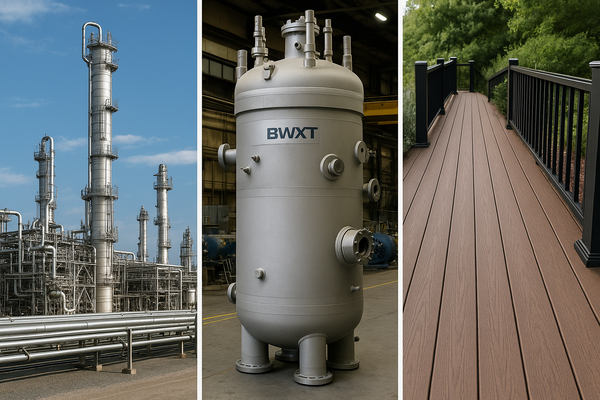
Industrial companies released a clutch of earnings and analyst notes this week that created clear winners and fresh areas of caution. Argan (NYSE:AGX) drew attention for its attractive valuation on accelerating power-infrastructure demand, while BWX Technologies (NYSE:BWXT) reported margin pressure and launched a $1.0 billion convertible note plan on November 5, 2025. TREX (NYSE:TREX) saw a sharp sell-off after Q3 results missed and management cut both revenue and profit outlooks. These items matter now because Q3 reports and financing moves are resetting near-term cash-flow expectations, and they shape capital-allocation choices ahead of year-end for U.S., Canadian and global industrial names.
The next paragraphs pull the headlines together, then place them in context for investors watching balance-sheet resilience, project backlog quality and valuation gaps across contractors, specialty manufacturers and infrastructure services.
Headlines: earnings misses, upgrades and financing moves that moved prices
Argan (NYSE:AGX) surfaced in the news as an undervalued play on power-infrastructure spending. Analysts point to strong long-term demand for boiler, turbine and modular plant work tied to utilities and renewables conversions. Coverage cited an appealing valuation relative to backlog and project ramps, making the stock a candidate for patient investors focused on multi-year returns.
BWX Technologies (NYSE:BWXT) reported a marginal decline in net profit margin to 10.0% from 10.3% year-over-year and flagged steady but modest five-year earnings growth (annualized 0.2%). Management also announced a proposed offering of $1.0 billion aggregate principal amount of convertible senior notes due 2030 on November 5, 2025. The financing signals balanced capital needs for growth programs while adding leverage and potential dilution that investors must price in.
Trex (NYSE:TREX) posted Q3 results that missed expectations and prompted management to cut revenue and profit guidance. The stock plunged on the announcement and multiple brokerages adjusted ratings. The episode highlights how quickly cyclical exposure and lower-volume outcomes can alter growth narratives for specialty building-materials names.
Quarterly disclosures and analyst notes also included slide decks and transcripts from mid-size contractors and service firms: Centuri Holdings (NASDAQ:CTRI) published a Q3 presentation, and Parsons (NYSE:PSN) and EMCOR Group (NYSE:EME) made investor-facing remarks that emphasized backlog, contract mix and margin execution. Owens Corning (NYSE:OC) held a Q3 call that reiterated demand in insulation and roofing but left some guidance assumptions under scrutiny.
Sector pulse: what the reports say about demand, margins and capital
Across these releases, three recurring themes stand out. First, project backlog remains a key differentiator. Firms with long-duration utility or government contracts display greater revenue visibility. Parsons and Centuri highlighted backlog as the primary buffer for near-term revenue volatility.
Second, margins are diverging by business mix. BWXT’s 10% net margin contrasted with stronger margin profiles in certain specialty contractors that control pricing on turnkey projects. Where commodity input costs and freight pressures persist, margin compression is a live risk.
Third, capital actions matter. BWXT’s $1.0 billion convertible note plan (announced November 5, 2025) and other financing choices will influence balance-sheet flexibility and equity dilution expectations. Companies that can fund growth from operating cash flow will command a premium relative to those needing external capital.
Winners & laggards: positioning, valuation and risks
Argan (NYSE:AGX) — Opportunity: Argan’s appeal is valuation tied to a long pipeline of power and energy-transition projects. Risk: project execution and timing can extend cash conversion cycles; contracts are lumpy and sensitive to utility capex cycles.
BWX Technologies (NYSE:BWXT) — Opportunity: exposure to nuclear and government contracts offers structural demand. Risk: a slight margin decline to 10.0% and the convertible note offering could increase leverage and potential stock dilution, so investors should weigh near-term financing against long-term contracts.
Trex (NYSE:TREX) — Laggard: Q3 misses and guidance cuts signaled weaker demand or margin pressure in decking and composite materials. Risk: management’s revised outlook suggests a pause in the growth story; multiple downgrades followed, reflecting higher execution risk.
Centuri Holdings (NASDAQ:CTRI) and Parsons (NYSE:PSN) — Mixed: Centuri’s Q3 slide deck emphasized project wins in energy-infrastructure work, while Parsons stressed stability in government-related engineering. Both benefit from backlog but must manage labor and subcontractor cost growth to protect margins.
Owens Corning (NYSE:OC) and Simpson Manufacturing (NYSE:SSD) — Selective strength: building-products firms with strong roofing, insulation and connector products retain end-market exposure to remodeling and non-residential activity. However, Trex’s missed quarter is a reminder that durable-goods demand can soften quickly if housing cycles cool.
Sterling Infrastructure (NASDAQ:STRL) — Caution: recent coverage suggested the stock is stretched given current multiples versus near-term project risks. Data-center orders are a bright spot, but valuation appears to price in continued high growth that is not yet fully realized.
What smart money is watching next
- December and year-end backlog updates: Watch quarterly backlog disclosures from Parsons (NYSE:PSN) and Centuri (NASDAQ:CTRI) for changes to revenue visibility and any revisions to multi-quarter project schedules.
- BWXT capital structure implications: Monitor tranche details and pricing after the November 5, 2025 convertible note announcement (expected sale to qualified institutional buyers). Pricing and conversion terms will clarify dilution risk and impact on leverage metrics.
- TREX guidance revisions and seasonality: Track Trex’s next trading update for any incremental guidance tweaks or inventory adjustments that would signal a deeper slowdown in end-market DIY and contractor demand.
Closing take-away
The single most important insight is this: differentiation now comes from backlog quality and capital flexibility. Firms with secured, long-duration contracts and conservative financing plans offer the clearest near-term defensive advantage. Conversely, companies exposed to volatile end markets or that issue large amounts of new capital — like the convertible note program at BWXT — require closer scrutiny on dilution and margin recovery timelines. For investors, the path forward is selective: prioritize balance-sheet strength and contract visibility while watching earnings revisions and financing terms that can rapidly change risk-reward profiles.












